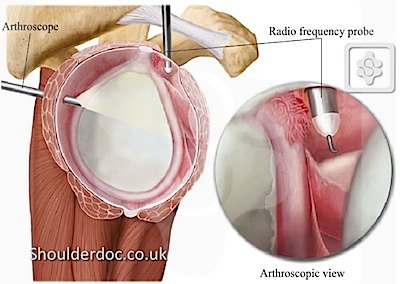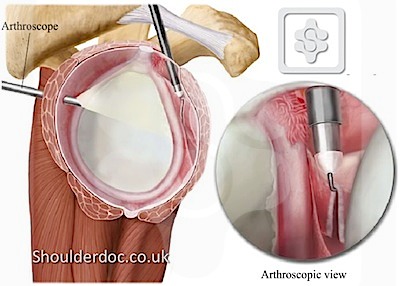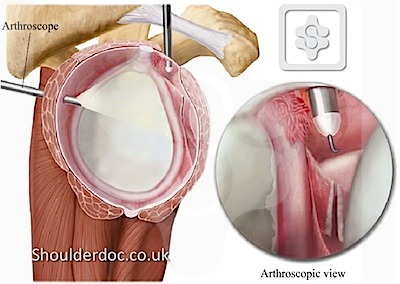Capsular Release
www.shoulderdoc.co.uk
The operation aims to reduce the recovery time by freeing the joint to gain full range of movement and reduce pain.
This is keyhole surgery where the tight capsule of the joint is released with a special radio-frequency probe.
Traditionally a manipulation under anaesthesia (MUA) has been the surgery performed forFrozen Shoulder . This involves freeing the shoulder by manipulating it under a general anaesthetic . It has been an effective operation for most people with simple frozen shoulders. However, the capsular release is performed with increased precision by key hole surgery, and is called an arthroscopic capsular release. The results are successful in over 80% of patients and the freedom from pain is quicker than MUA. Arthroscopic capsular release also allows the surgeon to look around the shoulder joint with the arthroscope for any other lesions or injuries. Capsular release is safer and more effective than MUA for people who have developed a resistant stiff (frozen) shoulder after injury, trauma or fractures, as well as for diabetics.
Capsular Release involves cutting and removing the thickened, swollen inflamed abnormal capsule, as seen in the images below:

A special radiofrequency thermal probe is used to cut and remove abnormal capsule tissue.

The tight, constricted capsular ligaments are cut, thus freeing the joint again.


A special radiofrequency thermal probe is used to cut and remove abnormal capsule tissue.

The tight, constricted capsular ligaments are cut, thus freeing the joint again.

GENERAL GUIDELINES
PAIN
A nerve block is used during the operation which means that immediately after the operation the shoulder and arm may feel numb. This may last a few hours. After this the shoulder may well be sore and you will be given painkillers to help this whilst in hospital. These can be continued after you are discharged home. Ice packs may also help reduce pain. Wrap frozen peas or crushed ice in a damp, cold cloth and place on the shoulder for up to 15 minutes. In order to maintain a dry wound cover the dressing / wound with some cling film before applying the ice pack.
THE WOUND
This is a keyhole operation usually done through two or three 5mm puncture wounds. There will be no stitches only small sticking plaster strips over the wounds. These should be kept dry until healed. This usually takes 5 to 7 days.

WEARING A SLING
You will return from theatre wearing a sling and/or Cold compression wrap . This is for comfort only and should be discarded as soon as possible (usually within the first 2 to 4 days). Some people find it helpful to continue to wear the sling at night for a little longer if the shoulder feels tender.
SLEEPING
- Sleeping can be uncomfortable for a while if you try and lie on the operated arm. We recommend that you lie on your back or on the opposite side, as you prefer. Ordinary pillows can be used to give you comfort and support.
- If you are lying on your side one pillow slightly folded under your neck gives enough support for most people.
- A pillow folded in half supports the arm in front and a pillow tucked along your back helps to prevent you rolling onto the operated shoulder during the night.
- If you are lying on your back, tie a pillow tightly ion the middle (a "butterfly pillow") or use a folded pillow to support your neck. place a folded pillow under the elbow of the operated arm to support that.


PAIN CONTROL
Some degree of discomfort is common after surgery. You should not have to 'put up' with pain. You will be given painkillers and anti-inflammatories from the hospital. The Cold compression wrap also helps reduce inflammation and pain.
DRIVING
You may begin driving when you feel able to handle a steering wheel easily with both arms. You should be able to get your arm above shoulder level comfortably and manipulate objects at this level. For most patients this is usually about one week after surgery. If you are unsure, check with your therapist and/or surgeon.
RETURNING TO WORK
This will depend on your occupation. If you are in a sedentary job you may return as soon as you feel able usually after one week .
If your job involves heavy lifting or using your arm above shoulder height you may require a longer period of absence.
If your job involves heavy lifting or using your arm above shoulder height you may require a longer period of absence.
LEISURE ACTIVITIES
You should avoid sustained, repetitive overhead activities for three months. With regard to swimming you may begin breaststroke as soon as you are comfortable but you should wait three months before resuming front crawl. Golf can begin at six weeks. For guidance on DIY and racquet sports you should speak with your physiotherapist.
FOLLOW UP APPOINTMENT
A follow up appointment will be made for approximately three weeks after your operation. The amount of physiotherapy will depend on your individual needs.
PROGRESS
This is variable. However experience shows us that by 3 weeks movement below shoulder height becomes more comfortable. By this stage you should have almost full range of movement although there will probably be discomfort when moving the arm above the head and when lying directly on your shoulder.
At three months after your surgery your symptoms should be approximately 80% better. It can take 6 to 9 months to fully recover and you will continue to improve for up to a year following the procedure.
PHYSIOTHERAPY
Physiotherapy is essential after the operation, to encourage good movement, help with pain management and rehabilitate the muscles back to normal function. You will need to see a therapist within a few days of the surgery. This should be arranged in advance of the surgery.
Sem comentários:
Enviar um comentário
Gostou do meu Blog? Envie a sua opinião para lmbgouveia@gmail.com